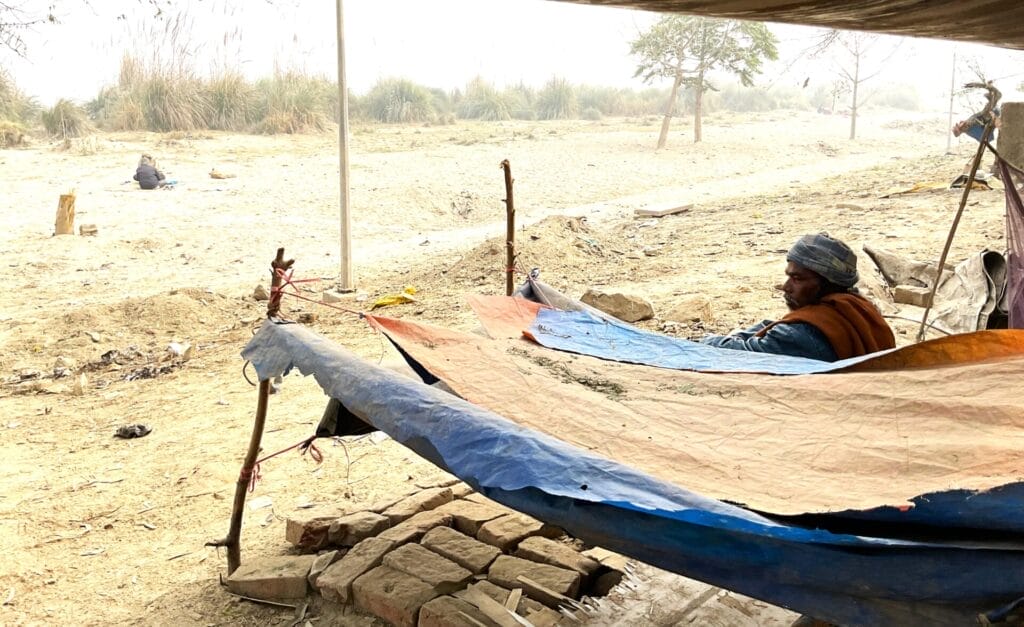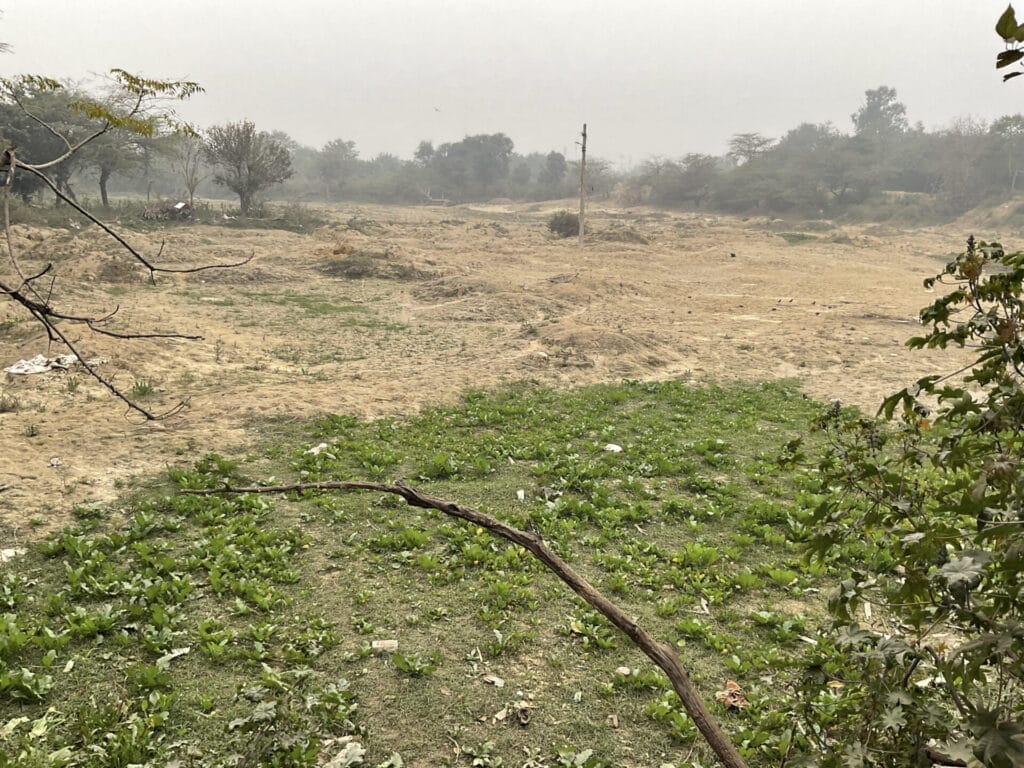Rekha, a farmer in Delhi’s Yamuna Pushta, has been sitting in protest for the last 21 months along with other members of her community. Their demand is clear: “The farms that they (the government) have destroyed were our only occupation; the government must either give us employment in its place, or compensation for the loss we have suffered. Since they have also demolished the homes of farmers, we demand a place to live as well,” says Rekha firmly.
Rekha belongs to a community of farmers spanning three generations or more, comprising nearly a thousand households at Bela Estate, a slum cluster located on the western bank of the Yamuna. Sub-areas within that larger area include China Colony, Bela Gaon, Moolchand Basti, Malla Gaon and Kanchanpuri. In recent years, residents here have encountered multiple eviction drives carried out by state authorities, resulting in the dismantling of their housing units and the farmlands they cultivated. And so they have been staging a dharna since April 2, 2022, demanding rehabilitation.
Last year alone, Bela Estate saw several eviction drives in March and April, resulting in the demolition of over 800 houses alongside their cropping fields. The demolition occurred after the Delhi High Court rejected the appeal made by the Bela Estate Mazdoor Basti Samiti, an association that had requested rehabilitation after receiving eviction notice from the DDA. The association’s writ petition also contested the eviction order.
Sudarshan, who has been cultivating this patch of land since childhood, recounted the demolition in March. “They came and demolished our farms in March while we were in the midst of harvesting cauliflowers, carrots and coriander. They cleared out everything. A few weeks later, they returned and asked us to vacate the makeshift shelters we were living in, only to demolish them as well”, he says, “And now they falsely accuse us, claiming that these vegetables are toxic.”

Farming policy: DDA’s turnaround
In the pre and post-independence era, farming along the Yamuna was actively encouraged as a sustainable livelihood option for Delhi’s expanding population. In 1949, the Delhi Improvement Trust (DIT) allocated 8902 bighas of riverine land spread across four major revenue estates — Bela, Indrapat, Chiragah (North), and Chiragah (South) — to the Delhi Peasants Cooperative Multipurpose Society (DPCMS).
This official set up of tenant farming continued even after DIT was succeeded by the Delhi Development Authority (DDA) in 1956-57. However, the arrangement came to an unexpected halt in 1967, when DDA chose not to renew these leases, citing reasons that remain undisclosed to the general public.
Since that time, interactions between the DDA and the farming community have been marked by conflict. In 1991, when the DDA initiated eviction proceedings against all members of the Bela Estate Mazdoor Basti Samiti under the Public Premises Act, 1971, the farmers responded by presenting annual rent receipts and khasra girdawaris as evidence of their rightful occupation. They clung to these documents as proof of their long-standing ties to the land they had cultivated for generations.
However, in 2011, when bulldozers descended upon Bela Estate during a systematic demolition campaign, the farmers’ hopes were shattered. Despite their efforts to validate their land claims, the bulldozers spared no homes and destroyed standing crops across all five communities within Bela Estate. Since then, it has become a regular affair. Farmers keep rebuilding their homes and the state keeps demolishing the structures and evicting them.
Polluted waters and crop ban
In 2015, the National Green Tribunal (NGT) prohibited the cultivation of vegetables on the Yamuna floodplain until the river was restored to its natural state. The Delhi Development Authority (DDA) acquired the land on the floodplains of the Yamuna with plans to develop it into a biodiversity zone.
In February 2019, an NGT committee instructed the Central Pollution Control Board (CPCB) and the National Environmental Engineering Research Institute (NEERI) to conduct independent studies on farming practices on the Yamuna floodplain. By July of that year, NEERI submitted a report indicating elevated levels of lead in vegetables and corresponding soil samples from the floodplain, exceeding the safety limit recommended by the Food Safety and Standards Authority of India (FSSAI) of 2.5mg/kg.
Despite this, the committee suggested that farming could continue on the floodplains if regular monitoring of metal and pesticide levels in the produce is ensured. Subsequently, in August 2019, the CPCB’s report highlighted that excessive use of fertilizers and pesticides in floodplain farming was causing pollution of the Yamuna’s water and floodplains.
Following these findings, in September 2019, the NGT directed the DDA to halt the cultivation of fruits and vegetables on the Yamuna floodplains, warning of penalties for non-compliance by the central agency.
Farmers have expressed skepticism regarding these findings.
“We are not even sure if the samples tested in laboratories are from our own land or just fabricated. How can we trust these reports?” asks Rekha. She also mentions that they consume the same produce, feed it to their animals, and also supply it to the city. “What could have gone wrong with them?”
Another woman participating in the dharna voices similar concerns. “They falsely accuse us of polluting the Yamuna, but do nothing about city areas that are sending their sewage to the river. Farmers don’t dispose of their waste in the Yamuna; they simply cultivate their lands and sell their produce in the market.”
Read more: The trials of being an urban farmer in Delhi’s Yamuna floodplains
Is the state only interested in bourgeois urban farms then?
Despite their crucial role in food production for the city, farming communities on the Yamuna floodplains find themselves at the forefront of constant evictions in recent years. These evictions coincide with plans to transform their lands into parks and biodiversity zones, aligning with the objectives outlined in the Yamuna Riverfront Development Plan.
Hira Lal, another farmer, whose father came to Delhi’s floodplains in 1952 says, “We used to supply 50-60 trucks of vegetables every day to Delhi. It’s a farming stretch of 21 km from Wazirabad to Okhla. Back in 2004-2005, vegetables used to cost Delhi only 2-4 rupees. Now we are familiar with the city’s realities and how prices have escalated. In 2022, they began demolishing our structures in the name of G-20. I don’t even know what G-20 is.”

This highlights the bias in the urban farming narrative. On one hand, the state claims to celebrate the ingenuity of entrepreneurial farmers, on the other there is systematic dismantling of traditional farming at the core of Delhi. While industrial clusters and residential areas continue to pollute the Yamuna with impunity, farmers bear the brunt of blame and eviction, unfairly targeted as the face of pollution.
Farmers face daily harassment by the police, as they try to continue holding on to their lands. Rekha says, ‘The police constantly harass us, treating us like criminals. They destroy whatever temporary structures we have and take them away randomly. Their aim is to frustrate us to the point where we have to leave.”
Note: The author is one of six selected Fellows for the “Citizen Matters – Urban Environmental Reporting Fellowship 2023” focusing on the Delhi-NCR region. This short piece was produced as part of his work under the Fellowship.